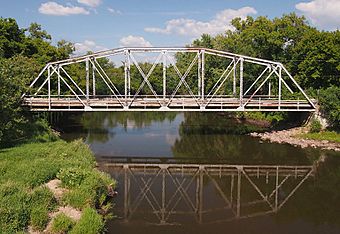Waterford Bridge facts for kids
Quick facts for kids |
|
|
Waterford Bridge
|
|

The Waterford Bridge viewed from the southwest
|
|
| Location | Canada Avenue over the Cannon River, Waterford Township, Minnesota |
|---|---|
| Area | Less than one acre |
| Built | 1909 |
| Built by | Hennepin Bridge Company |
| Architect | Charles A. Forbes |
| Architectural style | Camelback through truss |
| MPS | Iron and Steel Bridges in Minnesota MPS |
| NRHP reference No. | 10000580 |
| Designated | August 26, 2010 |
The Waterford Bridge is a really old and special steel bridge in Waterford Township, Minnesota. It crosses over the Cannon River. This bridge was built way back in 1909.
What makes it special? It's one of the first bridges in Minnesota to use a strong building method called rigid connections. This means the parts of the bridge are tightly joined together, not just loosely connected with pins. It's also the only road bridge in Minnesota known to use both bolts and rivets for these strong connections.
Because it's so unique and important for engineering history, the Waterford Bridge was added to the National Register of Historic Places in 2010. This list includes places that are important to the history of the United States.
Contents
What Does the Waterford Bridge Look Like?
The Waterford Bridge is a special kind of bridge called a camelback through truss. Imagine a bridge where the top part looks a bit like a camel's hump! The traffic goes through the main structure of the bridge.
This bridge is about 140 feet (43 meters) long. Its deck, where people walk or ride, is 16 feet (4.9 meters) wide. Even though it's only about 2 miles (3.2 km) from Northfield, Minnesota, the area around the bridge feels very peaceful and rural.
The Waterford Bridge is one of only a few camelback through truss bridges left in Minnesota. Other similar bridges on the National Register of Historic Places include the Gateway Trail Iron Bridge, the Dodd Ford Bridge, and the Long Meadow Bridge.
The Story of the Waterford Bridge
The Waterford Bridge was built in 1909. It took the place of an older bridge that had been there since at least 1896. A man named Charles A. Forbes, who was an engineer for Dakota County, designed the new bridge. The Hennepin Bridge Company built it for $5,000. That was a lot of money back then!
How the Bridge Was Built
When this bridge was built, most bridges were still made with parts held together by pins. But the builders of the Waterford Bridge chose to use stronger rigid connections. This was a new and better way to build bridges, even though it wasn't required by law yet. What's really unique is that many of these connections were made with bolts. This was a step between older pin-connected bridges and newer bridges that used only rivets.
Saving the Bridge
In the early 1980s, the bridge started to have problems because of erosion, which is when water or wind wears away the land. Local people cared a lot about the bridge and raised $40,000 to fix it.
However, by 1991, the bridge was too old and worn out for cars to drive on it safely. So, it was closed to traffic, and a new road and bridge were built nearby. In 2014, part of the bridge was rebuilt again with help from a grant. Today, the historic Waterford Bridge is used as a trail. People can walk, ride ATVs, or use snowmobiles on it.



